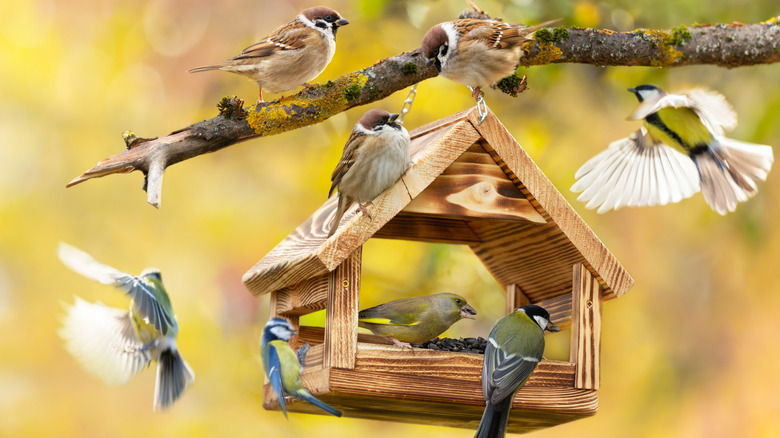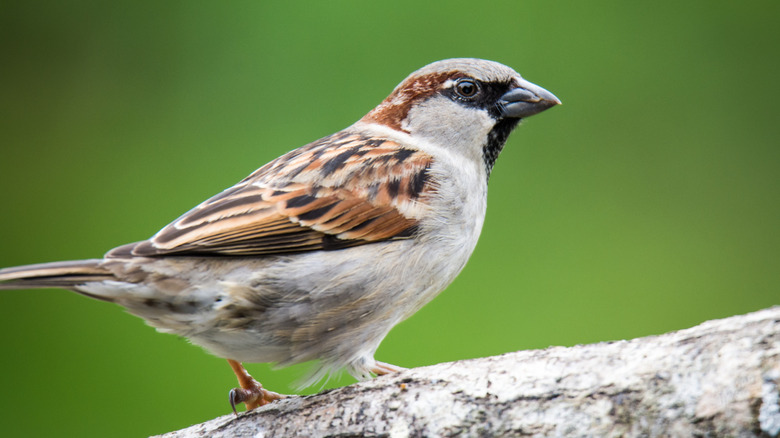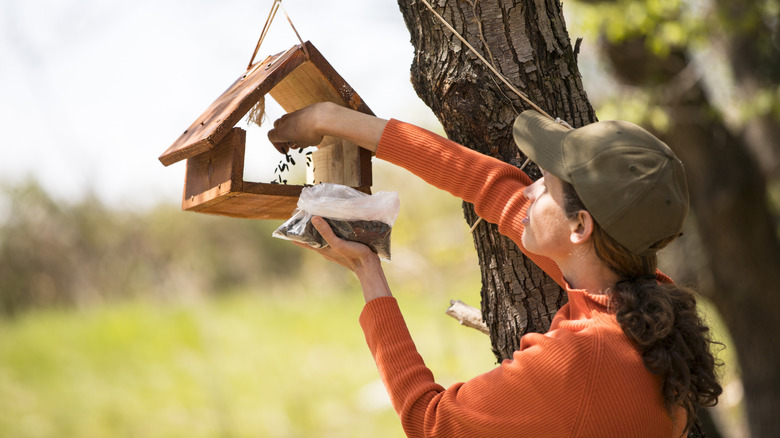The Common Backyard Bird You Don't Want To See Anywhere Near Your Bird Feeder
Having a bird feeder in your backyard can indeed be a rewarding experience. There are many things you should be looking for in a bird feeder to ensure the best outcomes possible, though. Not only are there different sizes of bird feeders to consider, but you also have the opportunity to pick different seeds to accommodate specific types of birds. While it can be exciting to have numerous species at your feeders, there are definitely some birds you do not want to see in your yard. House sparrows (Passer domesticus) are among the invasive varieties that could spell trouble if you spot them at your bird feeders because of the dangers they pose to native birds, often muscling them out of their homes and aggressively stealing their resources.
House sparrows are an exotic species of sparrows found in the U.S., but they're also among the most common types you'll see. They are native to Africa, Asia, and Europe and were introduced in North America in the mid-1800s from England. A nuisance to birds and humans, these sparrows are also adaptable, which is why you can find them everywhere from rural farms to urban homes. Notable signs of a house sparrow include dark brown feathers around their necks and backs, as well as gray around their chests. Male species also sport a black patch on their chests. Accurate identification is crucial, since you don't want to discourage desirable sparrow species from coming to your bird feeder.
House sparrows create problems for native birds in your area
House sparrows can cause problems for the more desirable native sparrow species, such as chipping sparrows and song sparrows. But their aggressive behaviors aren't limited to other sparrows and birds their own size. In fact, house sparrows target many common cavity-nesting species, such as bluebirds and purple martins, by taking their nesting boxes and houses.
Needless to say, these exotic sparrows are an unwelcome sight at your feeders. Like many other types of birds, house sparrows prefer eating close to their nests. Aside from stealing other birds' nesting spots, the sparrows could create property damage as they build their homes in and around human structures. In particular, house sparrows like to nest in various building cavities, including those around roofs, windows, gutters, and overhangs, which might understandably prompt you to learn how you can stop birds from nesting in the eaves of your home. You may even see them when you're running errands in areas like open-air shopping centers and parking lots.
Ways to limit the number of house sparrows at bird feeders
Due to the persistent and aggressive nature of house sparrows, it can be nearly impossible to keep these exotic birds away from your backyard completely. With that said, there are ways to help reduce their presence by making your outdoor spaces less welcoming. First, consider removing potential sources of food for them. House sparrows in general particularly favor cracked corn, millet, and milo, which are common ingredients in commercial bird seed mixes. The downside, of course, is that avoiding these ingredients could also mean less food for other birds in your area that enjoy them. This may be a necessity to help get the house sparrow population in your backyard under control, though.
You might also consider adding foods that house sparrows purportedly do not care for as a way to deter them from bird feeders, such as thistle seeds and safflower. You're also unlikely to find house sparrows at hummingbird feeders, since they do not eat nectar. Another option is to choose feeders with smaller openings and perches, as house sparrows might be less likely to use them. Cleaning up food spills underneath your feeders on a daily basis can help reduce unwanted wildlife, and this may even include these types of sparrows. If house sparrows continue to be a problem around your property and for nearby native bird species, consider contacting a wildlife professional for possible active control measures. They are your best resource for knowing how and when to move a bird nest in your yard, which is illegal for many native migratory bird species.


